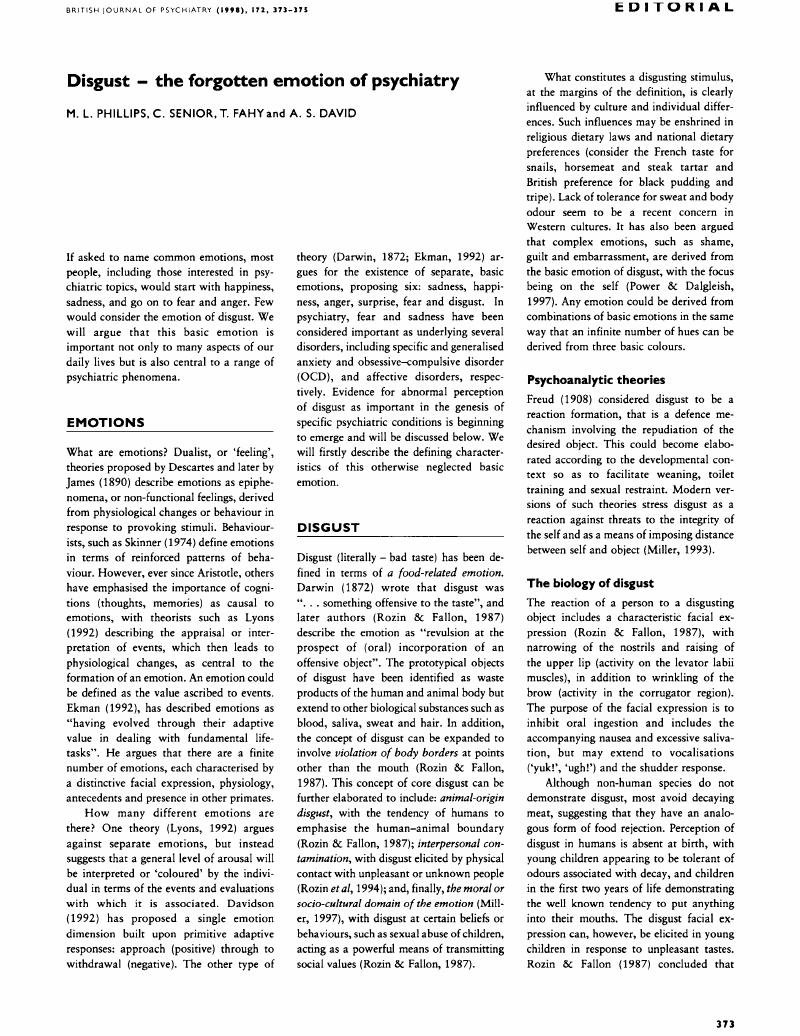Crossref Citations
This article has been cited by the following publications. This list is generated based on data provided by Crossref.
Phillips, Mary L.
Williams, Lea
Senior, Carl
Bullmore, Edward T.
Brammer, Michael J.
Andrew, Christopher
Williams, Steven C.R.
and
David, Anthony S.
1999.
A differential neural response to threatening and non-threatening negative facial expressions in paranoid and non-paranoid schizophrenics.
Psychiatry Research: Neuroimaging,
Vol. 92,
Issue. 1,
p.
11.
Muris, Peter
Merckelbach, Harald
Schmidt, Henk
and
Tierney, Sandy
1999.
Disgust sensitivity, trait anxiety and anxiety disorders symptoms in normal children.
Behaviour Research and Therapy,
Vol. 37,
Issue. 10,
p.
953.
Veale, David
1999.
Cognitive therapy in the treatment of obsessive—compulsive disorder.
Advances in Psychiatric Treatment,
Vol. 5,
Issue. 1,
p.
61.
Troop, Nicholas A.
1999.
Disgust discussed.
European Eating Disorders Review,
Vol. 7,
Issue. 2,
p.
150.
Macleod, AD
1999.
Disgusting Patients.
Progress in Palliative Care,
Vol. 7,
Issue. 6,
p.
299.
Merckelbach, Harald
Muris, Peter
de Jong, Peter J.
and
de Jongh, Ad
1999.
Disgust sensitivity, blood-injection-injury fear, and dental anxiety.
Clinical Psychology & Psychotherapy,
Vol. 6,
Issue. 4,
p.
279.
Druschel, B.a
and
Sherman, M.F
1999.
Disgust sensitivity as a function of the Big Five and gender.
Personality and Individual Differences,
Vol. 26,
Issue. 4,
p.
739.
Muris, Peter
Merckelbach, Harald
Nederkoorn, Sjaan
Rassin, Eric
Candel, Ingrid
and
Horselenberg, Robert
2000.
Disgust and psychopathological symptoms in a nonclinical sample.
Personality and Individual Differences,
Vol. 29,
Issue. 6,
p.
1163.
Troop, Nicholas A.
Murphy, Fay
Bramon, Elvira
and
Treasure, Janet L.
2000.
Disgust sensitivity in eating disorders: A preliminary investigation.
International Journal of Eating Disorders,
Vol. 27,
Issue. 4,
p.
446.
Pallanti, Stefano
and
Quercioli, Leonardo
2000.
Shame and Psychopathology.
CNS Spectrums,
Vol. 5,
Issue. 8,
p.
28.
Mancini, Francesco
Gragnani, Andrea
and
D'Olimpio, Francesca
2001.
The connection between disgust and obsessions and compulsions in a non-clinical sample.
Personality and Individual Differences,
Vol. 31,
Issue. 7,
p.
1173.
Stein, Dan J.
Liu, Yijun
Shapira, Nathan A.
and
Goodman, Wayne K.
2001.
The psychobiology of obsessive-compulsive disorder: How important is the role of disgust?.
Current Psychiatry Reports,
Vol. 3,
Issue. 4,
p.
281.
Troop, Nicholas A.
Treasure, Janet L.
and
Serpell, Lucy
2002.
A further exploration of disgust in eating disorders.
European Eating Disorders Review,
Vol. 10,
Issue. 3,
p.
218.
Schienle, Anne
Walter, Bertram
Stark, Rudolf
and
Vaitl, Dieter
2002.
Ein Fragebogen zur Erfassung der Ekelempfindlichkeit (FEE).
Zeitschrift für Klinische Psychologie und Psychotherapie,
Vol. 31,
Issue. 2,
p.
110.
SAAVEDRA, LISSETTE M.
and
SILVERMAN, WENDY K.
2002.
Case Study: Disgust and a Specific Phobia of Buttons.
Journal of the American Academy of Child & Adolescent Psychiatry,
Vol. 41,
Issue. 11,
p.
1376.
Vernon, Laura L.
and
Berenbaum, Howard
2002.
Disgust and fear in response to spiders.
Cognition and Emotion,
Vol. 16,
Issue. 6,
p.
809.
Schienle, Anne
Walter, Bertram
Schäfer, Axel
Stark, Rudolf
and
Vaitl, Dieter
2003.
Ekelempfindlichkeit: ein Vulnerabilitätsfaktor für essgestörtes Verhalten.
Zeitschrift für Klinische Psychologie und Psychotherapie,
Vol. 32,
Issue. 4,
p.
295.
Berenbaum, Howard
Raghavan, Chitra
Le, Huynh-Nhu
Vernon, Laura L.
and
Gomez, Jose J.
2003.
A taxonomy of emotional disturbances..
Clinical Psychology: Science and Practice,
Vol. 10,
Issue. 2,
p.
206.
Liu, Yijun
and
Gold, Mark S
2003.
Human Functional Magnetic Resonance Imaging of Eating and Satiety in Eating Disorders and Obesity.
Psychiatric Annals,
Vol. 33,
Issue. 2,
p.
127.
Schienle, Anne
Schäfer, Axel
Stark, Rudolf
Walter, Bertram
Franz, Michael
and
Vaitl, Dieter
2003.
Disgust Sensitivity in Psychiatric Disorders: A Questionnaire Study.
Journal of Nervous & Mental Disease,
Vol. 191,
Issue. 12,
p.
831.






eLetters
No eLetters have been published for this article.